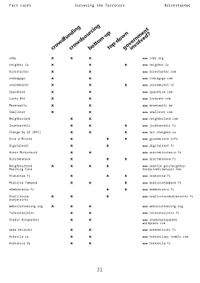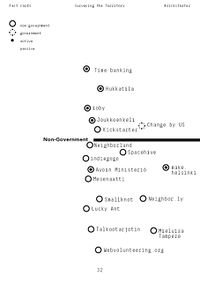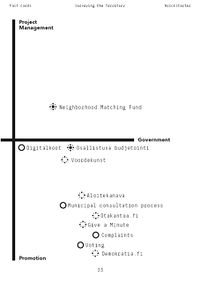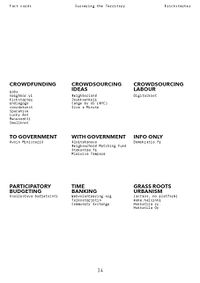Difference between revisions of "Crowdfunding / Crowdsourcing Platforms Urbanism"
| Line 47: | Line 47: | ||
[[File:beispiele_spacehive.jpg|910px|]] | [[File:beispiele_spacehive.jpg|910px|]] | ||
| − | from left to right: A New Wald for London Stevenson Square area in Manchester City Waterslide in Bristol | + | from left to right: A New Wald for London; Stevenson Square area in Manchester City; Waterslide in Bristol -->further information - [https://spacehive.com// Spacehive] |
| − | + | ||
| − | + | ||
| − | + | ||
Revision as of 14:29, 16 December 2014
Urban Crowdfunding Platforms offer space at the world wide web for people`s ideas, to present them to a broad audience. Everybody, over 18 which is declared in the terms & conditions, is allowed to create projects and share them on the platforms. The project conversion implicates high costs. To reach the whole amount for the project, people can help in form of donating. All these actions take place on the internet. This means platforms are like selling desks and they have to be created as clear and simple as possible, to catch the funder’s attention.
The best-known Urban Crowdfunding Platforms are spacehive, citizinvestor, brickstarter and Co. How they are working and what their ambitions are, is defined in this article. There is a big difference between Platforms of Crowdfunding and Crowdsourcing, like ioby or neighborland,...
The appearance of platforms for crowdsourcing is very attractive, because of awesome pictures and experiences which can be shared with everybody. Crowdsourcing defines the exchange of thoughts and ideas. You have to start with big brainstorming events to include the population catching their interests. With such a promotion method people get involved and their meanings and ideas will influence your plans which will be realised. Further down two examples for Urban Crowdsourcing platforms, ioby and neighborland, are mentioned.
Contents
[hide]Crowdfunding
Spacehive
"Most of us assume we have to take what we‘re given when it comes to neighbourhood planning. Where do you start if you want to change things? Spacehive creates a vibrant marketplace where you can discover great projects and make them happen with the click of a mouse. Forget battling bureaucracy - transforming your area can be as easy as buying a book online."
Spacehive is the world's first funding platform for civic projects. They make it easy for lots of people, companies and councils to fund civic projects that make places better - like new playgrounds or spruced up parks, new community centres, free public WiFi networks, rooftop gardens, street festivals, or a giant water slide in the middle of the high street. Anything that brings a benefit to a space that's accessible to the public - either permanently or temporarily.
„We’re leading transformation in the way that our towns and cities are shaped from a top-down delivery to a genuinely people-powered approach.“
If you‘re someone who wants to create a project, our dedicated management tool tells you everything you need to do to get your project funded and built. On top of that we‘re working with partners to develop an exciting range of benefits to bring your project to life - from free design advice to funding opportunities. Watch this space. You can‘t shortcut the need for planning permission. But Spacehive offers a faster, more democratic way of getting things done that puts communities in the driving seat.
AMBITIONS
- Everything on Spacehive must be a civic project: Projects must have a civic value, meaning the benefit should be felt in the places we share, rather than our private homes and offices. Projects can be permanent (like a new playground) or temporary (like an event) and they can include revenue as well as capital costs:
- A project is something with a clear end, like building a playground, planting a tree, or putting on a festival. A project will eventually be completed, and something tangible will be produced as a result
- It doesn't matter who you are: Creating projects is open to any organisation or person over the age of 18 and based in the UK. If you're an organisation it doesn't matter what your legal structure is - for example whether you're a charity or a for-profit business
- What is not allowed? Spacehive cannot be used to raise money for causes, whether it's a charity run for Oxfam or a fundraiser for the work of a local conservation group. Projects cannot offer equity or financial incentives (share of profits, ownership, the repayment of loans or cash-value equivalents). No offensive projects (e.g. murals with racist content) or projects that promote political or religious ideologies. Projects cannot offer rewards that offer entry to raffles, lotteries, or participation in gambling. No projects outside the UK.[1]
from left to right: A New Wald for London; Stevenson Square area in Manchester City; Waterslide in Bristol -->further information - Spacehive
Citizinvestor
Citizinvestor is a crowdfunding and civic engagement platform for local government projects. Certain users ("Project Creators") initiate campaigns to raise funds from other users (“Citizinvestors”) for government projects. „We empower citizens to invest in their community and create real change.“ Any government entity or their official partners can post projects to Citizinvestor.com. These are projects that have support from City Hall and citizens, but simply lack the necessary funds to be completed. Citizinvestors can continue to monitor the project’s progress as it goes from funding to fruition.[2]
THE CORE VALUES
Love where you live
No one likes the guy who hates his hometown. Every city is broken, we know that. But we believe we are called to love where we live.
Be audacious
Dream bigger. Have a healthy disrespect for the status quo. Never fear failure.
Be disciplined
Vision without discipline is false hope. We love lists and focus, because we know that’s what makes us most free to do the best work.
Be self-aware
We know what we’re good at and what we suck at and we love that quality in others.
'Transparency
'
Not lying is not enough. True transparency is in the best interest of everyone from customers, to employees, to partners.
Live generously
We believe that generosity makes us better citizens. One who lives generously seeks to put others above themselves, freely giving their time, energy, and resources.
Always be learning
Our love of learning spills into everything we do, from running constant experiments on our products, to A/B testing messaging, to always having a book in our hands.
For good, for profit
Profit and social impact are not mutually exclusive. We believe the best way to create real change is by creating new value in the marketplace.[3]
"One of the most innovative and relevant platforms in America." Mark Sharpe, Chairman of Hillsborough County Commission
“By piloting the Citizinvestor crowdfunding platform, we are encouraging public-private partnerships to achieve community goals and civic participation in City governance.”
Michael A. Nutter, Mayor of the City of Philadelphia
"Crowdfunding is a way for us to raise funds not only in Rhode Island, but across the country."
James Diossa, Mayor of the City of Central Falls
from left to right: Statue of Liberty Naperville, Illinois; Tally Porch Swing in Tallahassee; Urban Gardeining Naperville, Illinois
For further information - Citizinvestor
Brickstarter
BRICKSTARTER facilitates bottom-up initiatives by connecting them to local government. The website brings the rapid networking of social media together with a municipality's clout to "make good things happen in your neighbourhood". It goes out of its way to make it easy for citizens to join in with planning, inviting them to meetings and enabling them to donate money or skills.
It's a sophisticated tool for public decision-making. Or it would be if it actually existed. Because Brickstarter is just a prototype, what techies call a "beta" site. The idea is that it would be run by the city of Helsinki, but to test how such a tool should work, the designers felt they had to actually build it.
It's a sophisticated tool for public decision-making. Or it would be if it actually existed. Because Brickstarter is just a prototype, what techies call a "beta" site. The idea is that it would be run by the city of Helsinki, but to test how such a tool should work, the designers felt they had to actually build it.
In Brickstarter's case, one of the primary motives was to make public decision-making more positive. At the moment, public consultations tend to be negative by definition. The only way most people get the chance to be involved in changing their public realm is through Nimbyism: a notice comes through the door and you're given an opportunity to object – you're not actively encouraged to make your own proposals. Community activists can make things happen but, asks Sitra's Dan Hill, "How do you get from activism to simply activity, from heroes to everybody?"[4]
For further information - Brickstarter
Crowdsourcing
Ioby
ioby is a crowd-resourcing platform, Crowdfunding and Crowdsourcing, for citizen-led neighbor-funded projects. „Our name is derived from the opposite of NIMBY. Our mission is to strengthen neighborhoods by supporting the leaders in them who want to make positive change, engaging their neighbors, one block at a time.“
Crowd-resourcing combines the concepts of crowd-funding (the ability to pool small donations made online to a specific cause or project) and resource organizing (a core tenet of community organizing that considers activists and advocates the best supporters to ensure success of a cause or project). Crowd-resourcing gives everyone the ability to organize all kinds of capital--cash, social capital, in kind donations, volunteer time, advocacy--from within the community to serve the community. We believe that crowd-resourcing is a powerful way to build support and ensure success of a project.[5]
ioby is a not-for-profit corporation and connects vetted, well-planned NYC-based environmental initiatives with the support they need while raising public awareness and building partnerships for new solutions. In our online marketplace, charitable, community-based groups with limited resources can describe their projects, and users can explore the site, find meaningful projects, and make a donation or volunteer. The Sites provide you with access to an online collection of information, materials and services related to ioby and its work, including text, pictures, photographs, audio and video, graphics, logos, marks and images (collectively, "Content"), as well as software used in accessing the Sites, displaying the Content, and utilizing the functionality offered through the Sites ("Software"), all of which are subject to this UA. Unless stated otherwise, any new Content and Software added to the Sites and all revisions, modifications, and enhancements to the Sites, the Content or the Software will be covered by this UA effective upon the date of each such addition.[6]
As a nonprofit, we have a mission to make sure your project is successful. This means
- we have a very high rate of fully funded projects,
- we have a unique flexible finish policy that makes it easier for you to get the funds you raised,
- we have a low fee structure that intentionally supports early stage ideas and small projects,
- we host webinars specifically designed to support civic leaders.
Is there an evaluation and monitoring plan for the projects?
Yes. All project groups are required to post regular updates of their progress on their project's blog. When the project is completed, groups are required to submit a project evaluation and final expense report to ioby so that we can ensure the projects are completed as described in the project application, timeline, and budget. It is very important to us that we hold our projects accountable, because this builds trust with you, their best supporter.
For further information - ioby
Neighborland
Neighborland is an worldwide known crowdsourcing platform, which empowers organizations to collaborate with residents on local issues. They provide real-world design tools and a web-based communication platform.
“Our mission is to empower people to take action on local issues. We founded Neighborland on a simple question: ‘How can we help people improve their neighborhoods?’ First, we built tools for residents to sketch their own ideas and share insights with their neighbors. Then we launched Questions, enabling organizers to engage with residents. We recently released Projects to enable citizens, community leaders, and municipal officials to share resources, plan events, and work together to make great ideas happen.” Dan Parham Co-Founder, Neighborland
Solutions to our communities’ most important issues can be complex, and often organizations need residents to engage in a series of actions over time to make ideas a reality. Some issues require money or volunteers, others need petitions, or a visible show of community support. The structure for dialogue on Neighborland helps residents, organizations, and municipalities track campaigns and nudge them towards resolution.[7]
As we have evolved from an experiment to a social enterprise, we have developed these core values:
Action matters
We are experiential learners – we learn by doing. Small, incremental actions are an important way for residents to express their desires for their neighborhoods. Tactical interventions are not a replacement for traditional advocacy planning. Rather, they can inform the strategy of larger urban planning initiatives that require substantial amounts of time from experts and municipal funding. Not all prototypes succeed. If we want to innovate in our cities, we should embrace civic hacking as part of the urban design process.
Foster collaboration
We believe in open and transparent collaboration. Residents, community leaders, and municipal governments each have valuable perspectives on the development of our neighborhoods. Public dialogue about ideas big and small should be accessible, ongoing, and inclusive. Neighborland complements traditional advocacy forums like neighborhood meetings and city council hearings, adding voices and energy to ongoing debates and campaigns. Connecting residents with organizations who are already working on solving a problem is key. There is no us or them.In the wise words of Theodore Roosevelt, “We are the government.”
Social enterprise
We exist to make a visible, positive impact on the people, environment, and economic conditions of the communities where we work. Because accessibility and equity are core values of ours, Neighborland will always be free to use for residents. We have been working on several paths to sustainability as an organization. Whatever path we take, we won’t break with our core values. Our purpose is to help communities become, in Douglas Farr’s words from Sustainable Urbanism, more “connected, compact, and complete.” By fostering the capacity for likeminded residents and community leaders to take action on their most important problems, we will help them build healthy, vibrant, and resilient cities.
DIFFERENCE – How to engage the public
Before your event, sign up to Neighborland with your organizations’s admin-friendly email, and send us your profile URL. We will set you up as an Organizer on Neighborland which will give you access to all of our input and moderation tools. Describe your Project goals, timeline, and outcome in detail in the “description” field of your question.
Swim with the Current
Engaging with residents in public space or at your event. For most place-based Projects, you will engage with residents in public space or at community events. For events in public space, we can not overstate the importance of foot traffic. Don’t expect people to come to you. You’ll get much better engagement from a bustling sidewalk, park, city plaza, or farmers market. One of the easiest ways to do this is to partner with existing cultural or civic events that residents love like block parties, arts festivals, and placemaking events.
Sparking Conversation
There are three simple ways to collect input in public space with our tools – stickers, posters, or whiteboards. Our stickers work on any surface like glass, plastic, concrete, or wood. They are non-destructive in that they peel off any surface without leaving residue or damaging it. Neighborland is working with stickers like “I Wish This Was” stickers, “I want ____ in my neighborhood”. Often organizations will print key information on the backs of the stickers, like their campaign URL and SMS/Twitter input instructions. Stickers are the most lightweight and mobile of all of the tactics. Organizers can print their own posters or stickers using our DIY design toolkit. Remember to keep stickers within reach for all residents. For example, stickers should not be placed higher than 30” from the street level for residents in wheelchairs and children.[8]
Ariel Schwartz writes about Neighborland - A Social Network For Neighborhoods:
Neighborland takes the neighborhood revitalization theme a step further, acting kind of like a Digg or Reddit for neighborhood ideas. Go to the New Orleans page, and you’ll see a list of suggestions from users—things like "I want a Computer Science department at Tulane in New Orleans" and "I want a lot more recycle bins available/visible all over the city in New Orleans." Anyone who is signed in can comment or click the "Me Too" button to indicate that they would like the suggestion to be taken seriously. Users can sort through suggestions by what’s current, popular, or new. When an idea gains enough traction, Neighborland tries to make sure that the appropriate local agencies see it. In one example, a Neighborland idea to bring the new downriver streetcar in New Orleans to Poland Ave. was so popular that Transport for NOLA and Neighborland teamed up ensure that the request was added to the New Orleans Regional Transit Authority’s request for federal funding. After an online petition garnered over 2,200 signatures, Neighborland held an event with local residents and community leaders to bolster support even more.
Neighborland was incubated in New Orleans—that’s why there are so many ideas for the city on the site—but it’s now open to a handful of other locations, including Boulder, Houston, and Minneapolis. It will open up even further in the future. It’s too early to tell whether Neighborland will be successful on a country-wide scale, but a blog post from the Obvious Corporation sums up the need for the service:
"We don’t live in a 1950s TV show. It’s unlikely in most neighborhoods that residents will walk over, knock on your door, introduce themselves, and ask how they can help. However, 'signing in’ to your neighborhood and connecting with those who live around you about shared issues—speed bumps, recycling, whatever—that is a more likely and familiar scenario nowadays. Neighborland has the potential to unite residents and profoundly upgrade our neighborhoods." [9]
For further information - Neighborland
Conclusion
SIMPLE – CLEAR – FAST
These three words explain best what Crowdfunding Platforms define. Spacehive or Citizinvestor are really easily structured websites, accessible for everybody and their aim is immediately recognized. Most of these websites are based on the Aida Marketing principle and manuals how to use and create a profile. (verlinkung) On the first page they explain their ambitions and how they use to work. Then you can find two parts, to create or to support. This frame is equal to all the other platforms. The presentation of the projects is very clear and structured – it is very easy to support or like your favorite project. It`s almost impossible to get in struggle with a Crowdfunding Platform. The same applies for Crowdsourcing Platforms – their advantage is that they can use pictures to show the development and progress of the project. When you browse through neighborland you get a great, warm and comfortable feeling when you see their works and ambitions. It`s a practical way of promotion with a very successful outcome.
References
- Jump up ↑ [Crowdfunding Urbanism Platform Spacehive, http://spacehive.com/Home/AboutUs]
- Jump up ↑ [Crowdfunding Urbanism Platform Citizinvestor http://www.citizinvestor.com/about]
- Jump up ↑ [Citizinvestor Helps Grab The Ears of Local Governments, http://mashable.com/2012/09/18/crowdfunding-local-government/]
- Jump up ↑ [The Guardian, Justin McGuirk; Brickstarter: crowd-funding takes to the streets; http://www.theguardian.com/artanddesign/2012/aug/24/brickstarter-crowd-funding]
- Jump up ↑ [Design NYC, http://www.designyc.org/lorem-ipsum]
- Jump up ↑ http://www.ioby.org/about
- Jump up ↑ [Ambitions, Goals of Neighborland http://candychang.com/neighborland/]
- Jump up ↑ [Crowdsourcing Platform, Neighborland http://handbook.neighborland.com/about/]
- Jump up ↑ [Ariel Schwartz, Neighborland - A Social Network for Neighborhoods http://www.fastcoexist.com/1679770/neighborland-a-social-network-for-neighborhoods]








